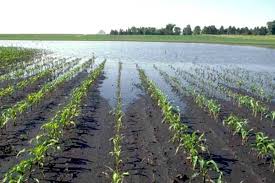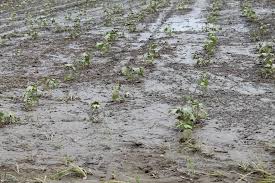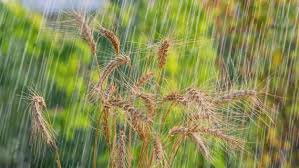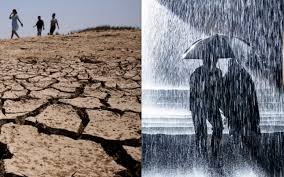Changing precipitation patterns are increasingly causing severe droughts and floods worldwide, highlighting a critical aspect of climate change. These shifts in precipitation result from rising global temperatures, which affect atmospheric circulation, cloud formation, and the water cycle.
As a result, certain regions experience prolonged dry spells, while others face intense and frequent rainfall, leading to flooding.
Droughts occur when an area receives significantly less rainfall than average, depleting water resources and damaging agriculture, ecosystems, and local economies. Changing precipitation patterns intensify these dry periods by reducing the frequency and consistency of rainfall in already vulnerable regions.
For example, parts of Africa, the Middle East, and even North America are increasingly affected by prolonged droughts, creating water shortages and affecting food production.
Conversely, extreme rainfall events can lead to floods, which pose serious threats to human lives, infrastructure, and the environment.
Rising temperatures increase the atmosphere’s capacity to hold moisture, leading to heavy downpours that can overwhelm drainage systems and cause rivers to overflow.
South Asia, for example, experiences severe monsoon flooding each year, while countries like the United States and parts of Europe have seen an increase in flash floods due to unpredictable storms.
The consequences of these changing precipitation patterns are profound. Droughts reduce crop yields, strain water supplies, and heighten wildfire risks, while floods lead to property damage, loss of life, and soil erosion. Both extremes threaten global food security, economic stability, and biodiversity.
Understanding the causes and impacts of these precipitation changes is essential for developing strategies to mitigate their effects and adapt to a rapidly changing climate.
Addressing these challenges requires international cooperation, investment in sustainable practices, and innovative approaches to water management and disaster preparedness.
The Science Behind Precipitation Variability
Precipitation variability is influenced by complex atmospheric processes and interactions:
1. Atmospheric Circulation: Global and regional atmospheric circulation patterns, such as the Hadley Cells, jet streams, and monsoon systems, play a crucial role in determining precipitation patterns by redistributing heat and moisture across the Earth’s surface.
2. Water Cycle Dynamics: The water cycle, driven by evaporation, condensation, and precipitation, regulates the movement and distribution of water vapor in the atmosphere. Variations in these processes contribute to seasonal and interannual precipitation variability.
3. Ocean-Atmosphere Interactions: Phenomena such as El Niño-Southern Oscillation (ENSO), Pacific Decadal Oscillation (PDO), and Atlantic Multidecadal Oscillation (AMO) influence global climate patterns and precipitation variability by altering sea surface temperatures and atmospheric circulation patterns.
4. Topography and Orographic Effects: Mountain ranges and topographic features can influence precipitation patterns through orographic lift, where moist air is forced to rise and cool, leading to enhanced precipitation on windward slopes and rain shadows on leeward slopes.
5. Urban Heat Island Effect: Urban areas with dense infrastructure and heat-absorbing materials can alter local temperature and precipitation patterns, creating microclimates that differ from surrounding rural areas.
Historical Trends in Precipitation Patterns

1. Regional Variability: Different regions exhibit diverse trends in precipitation, including increases, decreases, or shifts in seasonal patterns. For example, some regions experience more intense rainfall events, while others may face prolonged droughts.
2. Long-Term Trends: Observational data and climate records indicate that certain regions have experienced changes in average annual precipitation amounts and variability over decades, influenced by natural climate variability and anthropogenic factors.
3. Extreme Weather Events: The frequency and intensity of extreme precipitation events, such as heavy rainfall and flash floods, have shown an increasing trend in many parts of the world, impacting infrastructure, agriculture, and communities.
4. Snowfall Trends: Changes in snowfall patterns and snow cover duration affect hydrological cycles and water availability, especially in regions dependent on snowmelt for freshwater resources and agricultural irrigation.
5. Seasonal Shifts: Alterations in the timing and duration of seasonal precipitation, such as earlier or delayed onset of monsoon rains or winter snowfall, can disrupt agricultural schedules and ecosystems adapted to specific seasonal cycles.
The Relationship Between Climate Change and Precipitation
Climate change impacts precipitation patterns through various mechanisms:
1. Warmer Atmosphere: A warmer atmosphere holds more moisture, increasing the likelihood of intense rainfall events and potential for extreme precipitation events, leading to flooding in some regions.
2. Shifts in Weather Patterns: Climate change alters atmospheric circulation patterns and weather systems, influencing the distribution and timing of precipitation across different seasons and geographic regions.
3. Melting of Ice and Snow: The melting of glaciers, ice caps, and snowpacks alters hydrological cycles, affecting regional water availability and contributing to changes in precipitation patterns over time.
4. Changes in Atmospheric Composition: Anthropogenic emissions of greenhouse gases and aerosols affect cloud formation processes, precipitation efficiency, and regional climate patterns, amplifying variability and trends in precipitation.
5. Feedback Mechanisms: Climate feedback loops, such as the albedo effect from melting ice and snow or changes in vegetation cover, can exacerbate regional climate variability and alter precipitation patterns through complex interactions.
Read Also: Importance of a Sick Bay in a Ruminant House
Factors Influencing Changes in Precipitation

1. Greenhouse Gas Emissions: Increased concentrations of greenhouse gases, such as carbon dioxide and methane, trap heat in the atmosphere, leading to global warming and altering precipitation patterns on regional and global scales.
2. Land Use Changes: Deforestation, urbanization, and agricultural practices can modify surface albedo, evapotranspiration rates, and local climate conditions, influencing precipitation patterns in nearby regions.
3. Aerosols and Air Pollution: Aerosols from industrial activities and biomass burning can impact cloud formation processes and precipitation patterns by altering cloud properties and atmospheric dynamics.
4. Natural Climate Variability: Natural climate phenomena, including volcanic eruptions, solar radiation variability, and ocean-atmosphere interactions, contribute to short-term fluctuations and variability in precipitation patterns.
5. Land-Sea Contrasts: Differential heating and cooling rates between land and ocean surfaces influence regional atmospheric circulation patterns, moisture transport, and precipitation variability along coastal areas and continental interiors.
6. Cryospheric Changes: Changes in polar ice sheets, sea ice extent, and permafrost dynamics affect global and regional climate systems, influencing precipitation patterns through feedback mechanisms and ocean-atmosphere interactions.
Understanding Droughts: Causes and Effects
Droughts are prolonged periods of abnormally low precipitation leading to water shortages and environmental stress:
1. Meteorological Drought: Caused by extended periods of below-average precipitation due to changes in atmospheric circulation patterns and weather systems.
2. Agricultural Drought: Occurs when soil moisture deficits impact crop growth and yield, affecting agricultural productivity and food production.
3. Hydrological Drought: Results from reduced water availability in rivers, reservoirs, and groundwater aquifers, affecting water supply for drinking, irrigation, and industrial use.
4. Socioeconomic Impacts: Droughts can lead to food insecurity, economic losses, migration, and social unrest, disproportionately affecting vulnerable populations and rural communities.
The Impact of Droughts on Agriculture and Food Security
Droughts have profound implications for agriculture and food security:
1. Crop Failure and Yield Losses: Reduced water availability and heat stress can lead to crop failure, lower yields, and economic losses for farmers dependent on rainfed agriculture.
2. Livestock and Pasture Degradation: Droughts diminish pasture productivity, increase feed costs, and threaten livestock health and survival, impacting pastoral communities and livestock-dependent economies.
3. Water Scarcity and Irrigation Challenges: Droughts reduce water availability for irrigation, affecting agricultural intensification efforts and exacerbating food production challenges in water-stressed regions.
4. Food Price Volatility: Drought-induced crop failures and reduced yields can lead to food price spikes, affecting food accessibility and affordability for consumers, particularly in low-income households.
Understanding Floods: Causes and Consequences
Floods are natural disasters characterized by the overflow of water onto normally dry land:
1. Riverine Floods: Result from heavy rainfall, snowmelt, or dam failures, causing rivers and streams to exceed their capacity and inundate surrounding areas.
2. Flash Floods: Occur rapidly in low-lying areas or urban centers due to intense rainfall, storm surges, or rapid snowmelt, posing immediate risks to life, property, and infrastructure.
3. Coastal Floods: Triggered by storm surges, high tides, or tsunamis, coastal floods inundate coastal communities, causing erosion, salinization, and damage to coastal ecosystems.
4. Socioeconomic Impacts: Floods disrupt transportation networks, damage infrastructure, homes, and agricultural fields, leading to displacement, economic losses, and long-term recovery challenges.
The Role of Urbanization in Flood Risks
Urbanization influences flood risks and vulnerabilities in several ways:
1. Impervious Surfaces: Urban development increases the percentage of impervious surfaces like roads, buildings, and parking lots, reducing natural infiltration and increasing surface runoff during heavy rainfall events.
2. Drainage Infrastructure: Inadequate stormwater drainage systems and aging infrastructure can exacerbate flood impacts in urban areas, leading to localized flooding and property damage.
3. Land Use Changes: Conversion of natural floodplains and wetlands for urban expansion reduces natural flood buffering capacity, increasing flood risk for adjacent communities and downstream areas.
4. Population Density: High population density in urban centers increases exposure and vulnerability to flood hazards, affecting public safety, evacuation logistics, and emergency response efforts.
Read Also: Stocking Management for Ruminant Animals
Regional Variations in Drought and Flood Patterns

Drought and flood patterns vary across regions due to geographical, climatic, and socioeconomic factors:
1. Arid and Semi-Arid Regions: Regions with low precipitation and high evaporation rates are susceptible to frequent droughts, impacting agriculture, water resources, and livelihoods.
2. Tropical and Monsoonal Climates: Intense monsoon rains can cause seasonal floods in river basins and coastal areas, affecting agriculture, infrastructure, and communities dependent on seasonal rainfall.
3. Mountainous Terrain: Mountainous regions experience localized precipitation patterns, contributing to flash floods, landslides, and debris flows during intense rainfall events or rapid snowmelt.
4. Coastal Zones: Low-lying coastal areas are vulnerable to storm surges, sea level rise, and coastal flooding exacerbated by climate change impacts, affecting coastal ecosystems and human settlements.
Economic Impacts of Changing Precipitation Patterns
Changing precipitation patterns have significant economic implications across various sectors:
1. Agriculture and Food Security: Crop failures, reduced yields, and livestock losses due to droughts and floods impact agricultural production, food prices, and rural livelihoods.
2. Water Resources and Infrastructure: Flood damage to infrastructure, including roads, bridges, and utilities, requires costly repairs and reconstruction efforts, affecting local economies and public budgets.
3. Tourism and Recreation: Extreme weather events, such as floods and prolonged droughts, disrupt tourism activities, outdoor recreation, and coastal economies dependent on favorable weather conditions.
4. Insurance Costs: Increased frequency and severity of droughts and floods escalate insurance premiums and claims payouts, influencing insurance markets and financial stability.
5. Energy Production: Water availability for hydropower generation and cooling purposes in thermal power plants can be affected by changing precipitation patterns, impacting energy production costs and reliability.
Mitigation Strategies for Droughts and Floods
Effective mitigation strategies help reduce vulnerability and enhance resilience to droughts and floods:
1. Early Warning Systems: Implementing timely flood forecasting and drought monitoring systems improves preparedness and enables proactive response measures, such as evacuation and resource allocation.
2. Land Use Planning: Adopting sustainable land management practices, preserving natural floodplains, and zoning regulations in flood-prone areas mitigate flood risks and minimize economic losses.
3. Water Storage and Reservoir Management: Investing in water storage infrastructure, such as dams and reservoirs, enhances water availability during droughts and regulates river flow to mitigate flood impacts downstream.
4. Ecosystem-Based Approaches: Restoring wetlands, mangroves, and natural habitats enhances natural flood and drought resilience, conserves biodiversity, and provides ecological services to local communities.
5. Diversified Agriculture: Promoting drought-resistant crop varieties, crop diversification, and sustainable irrigation practices improves agricultural resilience to changing precipitation patterns and water availability.
The Importance of Water Management and Conservation
Effective water management and conservation practices are crucial for sustainable development:
1. Water Efficiency: Implementing water-efficient technologies, irrigation scheduling, and rainwater harvesting systems optimize water use efficiency in agriculture, industry, and urban settings.
2. Sustainable Urban Design: Green infrastructure, permeable surfaces, and water-sensitive urban design reduce urban heat island effects, mitigate flooding, and enhance urban resilience to extreme weather events.
3. Integrated Water Resource Management: Adopting integrated approaches to water governance, stakeholder engagement, and transboundary cooperation enhances water security and resilience to climate variability.
4. Public Awareness and Education: Raising awareness about water conservation, sustainable lifestyles, and climate change adaptation fosters community engagement and collective action towards water stewardship.
Future Projections: Adapting to Changing Precipitation Patterns
Adapting to future changes in precipitation patterns requires proactive planning and adaptation measures:
1. Climate Resilient Infrastructure: Investing in climate-resilient infrastructure and building codes ensures infrastructure durability and safety against extreme weather events, reducing economic losses and disruption.
2. Research and Innovation: Supporting research on climate science, hydrology, and adaptation technologies promotes innovation in drought and flood forecasting, water management, and agricultural resilience.
3. Policy and Governance: Developing and implementing policies, incentives, and regulatory frameworks that prioritize climate adaptation, disaster risk reduction, and sustainable water management practices.
4. International Cooperation: Strengthening international cooperation, knowledge sharing, and capacity building enhances adaptive capacity and resilience to global climate impacts, including changing precipitation patterns.
Do you have any questions, suggestions, or contributions? If so, please feel free to use the comment box below to share your thoughts. We also encourage you to kindly share this information with others who might benefit from it. Since we can’t reach everyone at once, we truly appreciate your help in spreading the word. Thank you so much for your support and for sharing!
Read Also: The Impact of Inefficient Waste Management on Oceans

